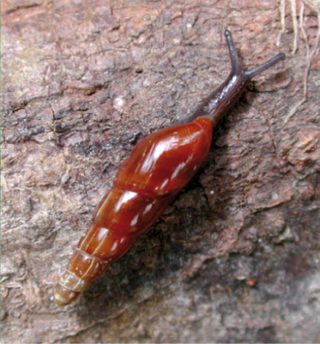Top Qs
Timeline
Chat
Perspective
Laevaricella perlucens
Species of gastropod From Wikipedia, the free encyclopedia
Remove ads
Laevaricella perlucens is a species of tropical, air-breathing land snail, a terrestrial pulmonate gastropod mollusk in the family Oleacinidae.
Remove ads
Distribution
Laevaricella perlucens is endemic to Dominica.[2] The type locality is "on Morne Diablotin, the north end on the island", Dominica.[1]
Laevaricella perlucens is very restricted in range[2] and probably meet the IUCN-criteria of Critically Endangered species.[2]
Description
Summarize
Perspective
Laevaricella perlucens was originally discovered and described (under the name Glandina perlucens) by British-born naturalist Robert John Lechmere Guppy in 1868.[1]
Guppy's original text (the type description) reads in Latin language and in English language as follows:
Glandina perlucens, n. sp.
Testa subulate-turrita, laevis, diaphana, fusco-flavida, vix striatula, lineis distautibus ornata; apex obtusissimus; anfractus 7, parum convexi, lente accrescentes, ultimas applanatus, spirse longitudinem circiter sequans; sutura valde impressa; columella valde torta, truncata; peristoma simplex, margine externo aliquanto prominente.
Long, 16 millim., lat. maj. 4 millim.; apart, alt. 4, lat. 2.
A subulate-turreted, smooth, brilliantly polished, yellowish-red shell, marked by obscure striae and by distant variciform lines, of which there are from three to six on a whorl; with a very obtuse apex and seven slowly increasing, scarcely convex whorls, the last somewhat flattened and equal to about half the length of the shell; columella strongly curved, truncate; aperture oval, elongate; peristome simple, its external margin somewhat prominent.
A species allied to G. afrcuata., Pf., of Jamaica. Of three examples I obtained, one only was of full growth.
This species had never been collected since it was described by Guppy (1868)[1] until 2009 and his type material was subsequently lost.[2] The single specimen collected alive in 2009 allowed figure this species for the first time.[2]
Remove ads
Ecology
This species is restricted to higher localities.[2] It does not occur, however, on the upper slopes of the higher peaks, but it seems to be restricted to the hygrophytic vegetation zone (cloud forest).[2]
References
Wikiwand - on
Seamless Wikipedia browsing. On steroids.
Remove ads

